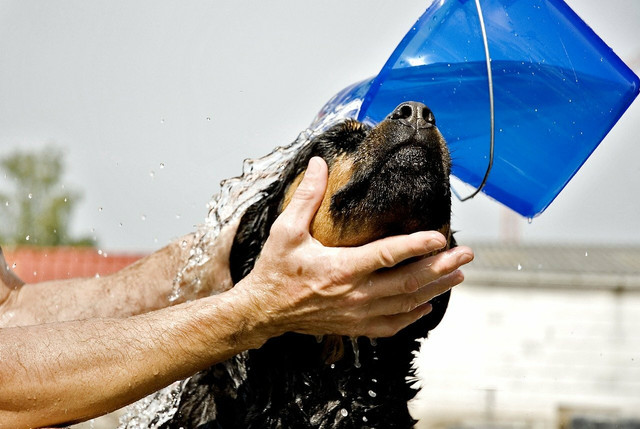Choosing a natural flea repellent is the best option for your dog. They are not just more cost-effective, they will protect your beloved pet from the harmful chemicals often found in store-bought products. Plus, you can easily make them at home.
There are dozens of natural flea repellents for dogs that can be produced at home, but the ‘tried-and-true home remedies outlined here are the safest and most effective. Be sure to dilute ingredients in water properly to avoid causing your dog discomfort.
1) Essential Oils as Natural Flea Repellents

(Foto: CC0 / Pixabay / mar_qs)
Essential oils such as tea tree, eucalyptus, rosemary citronella, and lavender are all-natural flea repellents that should be safe for your dog.
- Mixing just a few drops of essential oil into at least 500ml (16 fl. oz) of water is a quick and easy solution.
- Add the mix to a spray bottle, apply directly to your dog’s coat, and brush through evenly.
But be careful: In higher concentrations, certain essential oils might actually harm your pooch. If in doubt, try a ‘spot test’ on a small patch of your dog’s skin to see if there are any adverse reactions before properly applying your natural flea repellent.
2) Natural Flea Repellent for Dogs with Apple Cider Vinegar
Ideal and very safe for dogs, apple cider vinegar is a fantastic natural flea repellent. Simply create a 50-50 mixture of water and apple cider vinegar and thoroughly spray your dog’s coat. Fleas cannot stand vinegar and will avoid any pets treated with it.
White vinegar can be used as an alternative, just keep in mind that your dog may not enjoy the taste of it when they clean their fur. You could also try making your own homemade apple cider vinegar.
3) Lemon Wash to Prevent Fleas
A repellent made with lemons is another safe and easy way to protect your dog from fleas naturally. You can make lemon extract at home in a few minutes:
- Chop up some lemons.
- Add them to a jar.
- Pour boiled water over them.
Let the mixture sit overnight before rubbing or combing through your dog’s fur. Lemon is great for getting rid of fleas, as it not only repels them, it can also kill any eggs that have been laid.
How To Tell if Your Dog Has Fleas



(Foto: CC0 / Pixabay / Spiritze)
Itchy & Restless Dog
Keep an eye on your dog’s behavior. If your pet is itchy, they may seem especially restless or uncomfortable.
Check Your Dog’s Skin
If they’ve got fleas, your dog’s skin might look red or irritated and in more severe cases, there may be some hair loss and scabbing due to constant scratching. If this is this case, it is important to seek advice from a vet immediately so the broken skin does not become infected.
Just part some of your dog’s fur to directly expose the skin. You are looking for tiny dark insects roughly the same size as a pinhead. The groin and under the legs are the usual spots where fleas tend to congregate.
Fleas will usually be seen moving away from the exposed site. Flea larvae – either hatched or cocooned – is also a sure sign your dog has a flea problem.
Look For Flea Dirt
Finding little black flecks that look like bits of sand or pepper all over your house? Flea ‘dirt’ or excrement is another indicator of fleas on your dog. A simple test will determine whether the flecks are regular dirt or flea dirt. Simply wipe them with a white paper towel and add a few drops of water. If the flecks dissolve into a brownish color rather than holding their shape, most likely you are looking at flea dirt.
When To See Your Vet
Often dogs can have an allergic reaction to flea bites, which can lead to more serious problems like skin infections and in more severe cases, hematoma (which is when blood can gather outside of normal blood vessels under the skin due to constant scratching or shaking of the head). Either way, if your natural flea repellents have little effect, take your dog to the vet for a proper examination right away.
Tip: Ticks can also present a serious medical risk for your dog. Want to learn how to treat your dog for ticks? Read all about it here: Natural Tick Repellent for Dogs: Protecting Your Pet from Tick Bites
Keep Your Home Flea-Free, Naturally



(Foto: CC0 / Pixabay / StockSnap)
Making natural flea repellent for dogs is easy, but what about getting rid of these pests in your home?
Baking Soda
Baking soda works best rubbed deep into carpets and upholstery with a firm brush. For the best results, allow the baking soda to rest overnight before thoroughly vacuuming up. You will need to dispose of the vacuum’s contents immediately in a bin outside to avoid further re-infestation.
Salt
Similar to baking soda, salt will also quickly kill fleas due to its dehydrating properties. Sprinkle salt generously over the affected areas in the home and let it sit for at least 12 hours before vacuuming.
*Note: Baking soda and salt remedies will only eliminate adult fleas and do not have the ability to kill larvae. To properly rid the home of all fleas and larvae naturally means repeated vacuuming and disposal of debris at least once or twice a week until you notice a difference.
Flea Repellent Plants
Certain plant varieties contain chemicals and oils that act as natural flea repellents. In fact, their natural properties are so effective, they are often used in the production of natural pesticide products.
Such plants include lavender, spearmint, rosemary, citronella grass, and chrysanthemums to name only a few. By strategically placing these plants in and around your home, you will go a long way towards keeping fleas out of your home for good.
Extra Tips
To get rid of fleas, wash all bedding in the house (including your dog’s), and any washable seat and couch covers. Be sure to use hot water. Air-drying outside after washing is ideal, as this prevents any surviving fleas from lingering in your home.
Steam cleaning is also an effective option for carpets and upholstered furniture. You should also steam clean your dog’s bedding thoroughly.
Read more:
- 13 Noteworthy Houseplants That Are Safe for Cats and Dogs
- How to Get Rid of Carpet Beetles: 6 Natural Tips
- How to Get Rid of Aphids: Helpful Home Remedies
Do you like this post?






